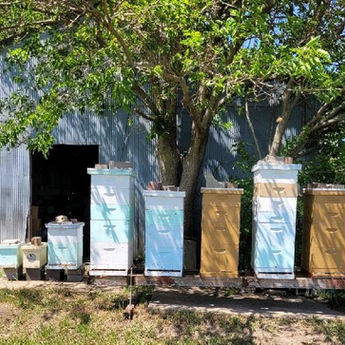Our Bee Yards
Where you locate your bee colonies ultimately impacts the taste and quality of the honey you harvest each year, as well as the health and well-being of your colonies. We have taken care to select prime locations in the placement of our colonies - locations that provide plant diversity which determines the varietals we can offer our customers. Our customers tell us that they cannot find honey that equals our honey, and we know the maintenance of our bees and the location of our hives impacts our final products!
Our varietals outlined on our About our Honey Products page, are typically harvested from a specific apiary. Tracking the apiary allows our local customers to choose an apiary close to their own residence - there is evidence that eating honey produced from plant nectar and pollen derived close to where you live may help people with seasonal allergies.
Currently, we have five bee yards, also called apiaries, in the central Iowa locale. See pictures below the write-up on the beeyards!
Blank Park Zoo Apiary
The zoo has a Plant Grow Fly conservation initiative to support native pollinators, and the bees support this program. The zoo administrators plant native plants throughout the zoo, and our bees take full advantage of those plants! The zoo also has Black Locust trees within a 3 mile radius of the beeyard, and the bees take full advantage and gather that nectar!
Take time to read the information on the zoo website, and how you can make a difference for all pollinators!
Urban Des Moines Apiary
Northwest Des Moines, close to the Des Moines river, where there is an abundance of native plants, and Basswood/Linden trees within a 1-mile radius of our beeyard. We have also taken the time and effort to plant 80% native plants on our property; native plants offer our bees and all pollinators the most nectar and pollen when compared to plants that are cultivars.
-
The bee colonies are located on the north end of our property, where they get early morning sun, and the shade of one of our maple trees in the hot afternoon.
-
We put out water feeders in our backyard for the bees - in 2021, we will be placing sea salt in the feeder, as our research indicates that the provision of sea salt provides the mineral balance needed for healthy, busy bees!
Ferguson Farms / Runnells West Apiary
Ferguson Farms (Runnells West), northwest of Runnells, on farmland, where there is an abundance of clover and Black Locust trees
-
The bees are located in a field of clover, under pecan trees, and in front of a pond. Large stands of Black Locust trees that bloom the end of May are within a half mile of our beeyard. The colonies get the early morning sun, the pecan trees provide shade from the hot afternoon sun and the pond the minerals and water needed for healthy, busy bees.
Van Ryswyk Farm - Indianola Apiary
Indianola, on conservation land, where the land has been planted in pollinator-friendly native plants. Large stands of Black Locust trees that bloom the end of May are within a 3-mile radius of our beeyard. We started the Indianola apiary in late summer 2019. John had a friend, Kyle, that wanted to start beekeeping, so we gave him a colony that we had caught in a swarm box. We also have five colonies of bees on his property for the 2022 season. The apiary is in a prime location - the land is in conservation! The honey from our harvest is delectable - some of the best we have harvested.
-
The bees are located in front of a field of land in the Conservation Reserve Program - see more information below. A pond is just around the corner from the beeyard.
Golden Goose Farm - Runnells North
A new beeyard for 2022 - Runnells North! Golden Goose Farm, north of Runnells and southeast of our Runnells bee yard, where there is an abundance of Black Locust trees and alfalfa fields. A very large grove of Black Locust trees is just 1/2 mile northwest of this beeyard. The colonies get the early morning sun, with a grove of trees that provide shade from the hot afternoon sun. The property owner is an environmental steward, and does not use any chemicals on her property - even her chickens are fed organic feed! We have placed 3 colonies at this beeyard this year - the colonies were derived from splits we did this spring, so we are not expecting an abundance of honey from this beeyard in 2022; however, if our bees survive the winter, we expect a great harvest in 2023! By the way, I highly recommend the eggs that our friend produces - you can contact Golden Goose Farm at (515) 205-2424 to pick up some eggs!































